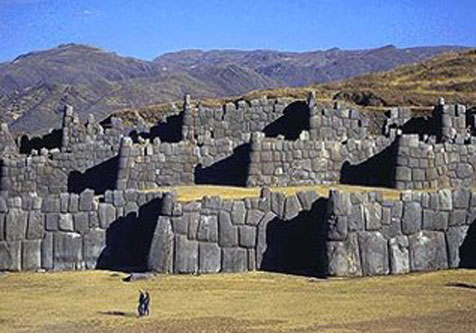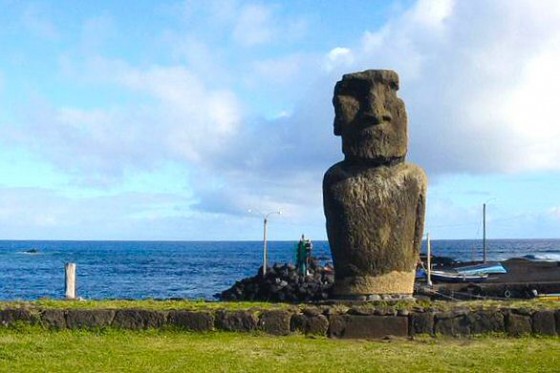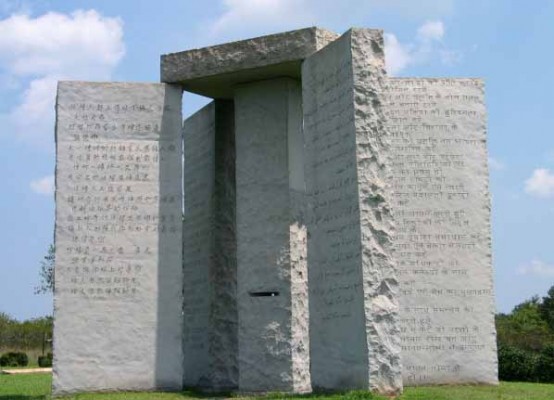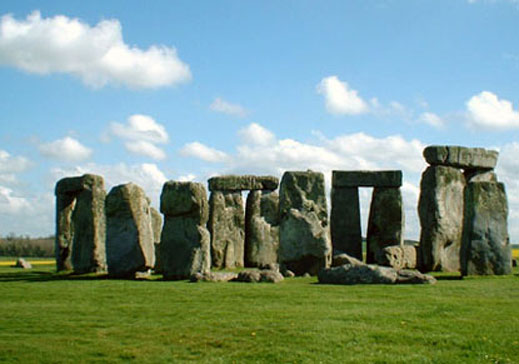Home > World > Top 10 Mysterious World Landmarks
Top 10 Mysterious World Landmarks
Posted on Thursday, December 30, 2010 by Girl Tattoos Designs Gallery
The world is filled with ancient monuments built by master craftsmen in order to honor everything from kings and presidents to religious figures. And although most of these landmarks have been carefully studied and researched by scientists and historians, some are simply so old, incomplete, or obscure that we still don’t know very much about why they were built or what purpose they served. The following are 10 world landmarks that, whether by intention or simply due to the passage of time, continue to baffle the people who study them.
10. The Cahokia Mounds

Cahokia is the name given to an Indian settlement that exists outside of Collinsville, Illinois. Archeologists estimate that the city was founded sometime around 650 AD, and its complex network of burial grounds and sophisticated landscaping prove that it was once a thriving community. It has been estimated that at its peak the city was home to as many as 40,000 people, which would have made it the most populous settlement in America prior to the arrival of the Europeans. The most notable aspect of Cahokia today are the 80 mounds of earth, some as high as 100 feet, which dot the 2,200-acre site. These helped create a network of plazas throughout the city, and it is believed that important buildings, like the home of the settlement’s chief, were built on top of them. The site also features a series of wooden posts that archeologists have dubbed “woodhenge.” The posts are said to mark the solstices and equinoxes, and supposedly figured prominently in the community’s astronomical mythology.
The Mystery
Although scientists are constantly discovering new information about the Cohokia community, the biggest mystery that remains is which modern Indian tribe is descended from the residents of the ancient city, as well as just what it was that caused them to abandon their settlement.
9. Newgrange

Considered to be the oldest and most famous prehistoric site in all of Ireland, Newgrange is a tomb that was built from earth, wood, clay, and stone around 3100 BC, some 1000 years before the construction of the pyramids in Egypt. It consists of a long passage that leads to a cross-shaped chamber that was apparently used as a tomb, as it contains stone basins filled with cremated remains. The most unique feature of Newgrange is its careful and sturdy design, which has helped the structure remain completely waterproof to this day. Most amazing of all, the entrance to the tomb was positioned relative to the sun in such a way that on the winter solstice, the shortest day of the year, the rays from the sun are channeled through the opening and down the nearly 60 foot passageway, where they illuminate the floor of the monument’s central room.
The Mystery
Archeologists know Newgrange was used as a tomb, but why and for who still remains a mystery. The painstaking design needed to guarantee that the yearly solstice event occurs suggests that the site was held in high regard, but other than the obvious hypothesis that the sun featured prominently in the mythology of the builders, scientists are at a loss to describe the true reason for Newgrange’s construction.
8. The Yonaguni Monument
Of all the famous monuments in Japan, perhaps none is more perplexing than Yonaguni, an underwater rock formation that lies off the coast of the Ryuku Islands. It was discovered in 1987 by a group of divers who were there to observe Hammerhead sharks, and it immediately sparked a huge amount of debate in the Japanese scientific community. The monument is made up of a series of striking rock formations including massive platforms, carved steps, and huge stone pillars that lie at depths of 5-40 meters. There is a triangular formation that has become known as “the turtle” for its unique shape, as well as a long, straight wall that borders one of the larger platforms. The currents in the area are known for being particularly treacherous, but this has not stopped the Yonaguni monument from becoming one of the most popular diving locations in all of Japan.
The Mystery
The ongoing debate surrounding Yonaguni centers on one key subject: is the monument a natural phenomenon, or is it man-made? Scientists have long argued that millennia of strong currents and erosion have carved the formations out of the ocean floor, and they point to the fact that the monument is all one piece of solid rock as proof that it was not assembled by a builder. Others, though, point to the many straight edges, square corners and 90-degree angles of the formation as proof that it’s artificial. They often cite one formation in particular, a section of rock that resembles a crude carving of a human face, as evidence. If they are right, then an even more interesting mystery presents itself: who constructed the Yonaguni Monument, and for what purpose?
7. The Nazca Lines

The Nazca lines are a series of designs and pictographs carved into the ground in the Nazca Desert, a dry plateau located in Peru. They cover an area of some 50 miles, and were supposedly created between 200 BC and 700 AD by the Nazca Indians, who designed them by scraping away the copper colored rocks of the desert floor to expose the lighter-colored earth beneath. The lines have managed to remain intact for hundreds of years thanks to the region’s arid climate, which sees it receive little rain or wind throughout the year. Some of the lines span distances of 600 feet, and they depict everything from simple designs and shapes to characterizations of plants, insects, and animals.
The Mystery
Scientists know who made the Nazca Lines and how they did it, but they still don’t know why. The most popular and reasonable hypothesis is that the lines must have figured in the Nazca people’s religious beliefs, and that they made the designs as offerings to the gods, who would’ve been able to see them from the heavens. Still, other scientists argue that the lines are evidence of massive looms that the Nazcas used to make textiles, and one investigator has even made the preposterous claim that they are the remnants of ancient airfields used by a vanished, technologically advanced society.
6. Goseck Circle

One of the most mysterious landmarks in Germany is the Goseck Circle, a monument made out of earth, gravel, and wooden palisades that is regarded as the earliest example of a primitive “solar observatory.” The circle consists of a series of circular ditches surrounded by palisade walls (which have since been reconstructed) that house a raised mound of dirt in the center. The palisades have three openings, or gates, that point southeast, southwest, and north. It is believed that the monument was built around 4900 BC by Neolithic peoples, and that the three openings correspond to the direction from which the sun rises on the winter solstice.
The Mystery
The monument’s careful construction has led many scientists to believe that the Goseck Circle was built to serve as some kind of primitive solar or lunar calendar, but its exact use is still a source of debate. Evidence has shown that a so-called “solar cult” was widespread in ancient Europe. This has led to speculation that the Circle was used in some kind of ritual, perhaps even in conjunction with human sacrifice. This hypothesis has yet to be proven, but archeologists have uncovered several human bones, including a headless skeleton, just outside the palisade walls.
5. Sacsayhuaman

Not far from the famous Inca city of Machu Picchu lies Sacsayhuaman, a strange embankment of stone walls located just outside of Cuzco. The series of three walls was assembled from massive 200-ton blocks of rock and limestone, and they are arranged in a zigzag pattern along the hillside. The longest is roughly 1000 feet in length and each stands some fifteen feet tall. The monument is in astonishingly good condition for its age, especially considering the region’s propensity for earthquakes, but the tops of the walls are somewhat demolished, as the monument was plundered by the Spanish to build churches in Cuzco. The area surrounding the monument has been found to be the source of several underground catacombs called chincanas, which were supposedly used as connecting passageways to other Inca structures in the area.
The Mystery
4. The Easter Island Moai

One of the most iconic series of monuments in the Pacific islands is the Moai, a group of huge statues of exaggerated human figures that are found only on the small, isolated island of Rapa Nui, or Easter Island. The Moai were carved sometime between 1250 and 1500 AD by the island’s earliest inhabitants, and are believed to depict the people’s ancestors, who in their culture were held in the same regard as deities. The Moai were chiseled and carved from tuff, a volcanic rock that is prevalent on the island, and they all feature the same characteristics of an oversized head, broad nose, and a mysterious, indecipherable facial expression. Scientists have determined that as many as 887 of the statues were originally carved, but years of infighting among the island’s clans led to many being destroyed. Today, only 394 are still standing, the largest of which is 30 feet tall and weighs over 70 tons.
The Mystery
3. The Georgia Guidestones

While most of the mysterious monuments on this list only became that way as centuries passed, the Georgia Guidestones, also known as American Stonehenge, are one landmark that was always intended to be an enigma. The monument, which consists of four monolithic slabs of granite that support a single capstone, was commissioned in 1979 by a man who went by the pseudonym of R.C. Christian. A local mason carefully crafted it so that one slot in the stones is aligned with the sun on the solstices and equinoxes, and one small hole is always pointed in the direction of the North Star. Most interesting, though, are the inscriptions on the slabs, which an accompanying plaque describes as “the guidestones to an Age of Reason.” In eight different languages, the slabs offer a strange ten-point plan to ensure peace on Earth that includes vague proclamations like “prize truth–beauty–love–seeking harmony with the infinite,” to very specific commands like “maintain humanity under 500,000,000 in perpetual balance with nature.” Comments like this one have made the Guidestones one of the most controversial landmarks in the United States, and they have long been protested and even vandalized by groups that would like to see them demolished.
The Mystery
2. The Great Sphinx of Giza

Sphinxes are massive stone statues that depict the body of a reclining lion with the head and face of a human. The figures are found all over the world in different forms, but they are most commonly linked with Egypt, which features the most famous example in the form of the Great Sphinx of Giza. Incredibly, the statue is carved out of one monolithic piece of rock, and at 240 feet long, 20 feet wide, and 66 feet tall, it is considered to be the biggest monument of its kind in the world. Historians largely accept the function of the Sphinx to have been that of a symbolic guardian, since the statues were strategically placed around important structures like temples, tombs, and pyramids. The Great Sphinx of Giza appears to be no different. It stands adjacent to the pyramid of the pharaoh Khafra, and most archeologists believe that it is his face that is depicted on that of the statue.
The Mystery
Despite its reputation as one of the most famous monuments of antiquity, there is still very little known about the Great Sphinx of Giza. Egyptologists might have a small understanding of why the statue was built, but when, how, and by who is still shrouded in mystery. The pharaoh Khafra is the main suspect, which would date the structure back to around 2500 BC, but other scientists have argued that evidence of water erosion of the statue suggests that it is much older and perhaps even predated the dynastic era of the Egyptians. This theory has few modern adherents, but if true it would mean the Great Sphinx of Giza is even more mysterious than previously believed.
1. Stonehenge

Of all the world’s famous monuments, none has gained as much of a reputation for pure, simple mystery as Stonehenge. Stonehenge has been inspiring debate among scholars, scientists, and historians since the Middle Ages. Located in the English countryside, the landmark is believed to date back to 2500 BC, and consists of several mammoth pieces of rock arranged and piled on top of one another in what appears at first to be a random design. The site is surrounded by a small, circular ditch, and is flanked by burial mounds on all sides. Although the rock formations that still remain are undoubtedly impressive, it is thought that the modern version of Stonehenge is only a small remnant of a much larger monument that was damaged with the passing of time, and it is largely believed that the building process was so extensive that it could have lasted on and off for anywhere from 1500 to 7000 years.
The Mystery
Category Article Amazing, Top 10, Travel, World
Blog Archive
-
▼
2010
(831)
-
▼
December
(148)
- Zoya Intimate Collection Spring 2011
- Drum roll ...
- Top 10 Mysterious World Landmarks
- The Best Stockholm Attractions
- Yellow Fevers ...
- Fear of Tomorrow-No Fuckin Future No Way EP
- Dead Prez- Let's Get Free (2000)
- Wolf Brigade-Comalive
- Right back at the office
- Devourment
- BeautyTicket 50% off sale
- Out Of Order- Paradise Lost (1986)
- Shades of Grey-Freedom.Incarceration
- Top Ten Animals in Space
- Ten of the Greatest Unresolved Mysteries
- Strangest creature found on Earth
- Beautiful Flower Creations
- Statue of Christ the Redeemer
- Wormholes, Wormholes
- NEXT MONDAY
- In the spirit of things ...
- Schwarzenegger Dog – Wendy The Bully Whippet
- Weird love from Birch
- Mobile Home Motorcycle
- Mustaches Perform Miracles
- Sonakshi Sinha — Maxim India December 2010
- Beautiful and Creative Kinetic Rings
- LED “Watch One”
- LED watches are amazing
- iPad-Compatible Clothing
- Coolest men's Ring collection
- Funny and Creative Tie Designs
- Bela Fleck & the Flecktones - Jingle All The Way (...
- MERRY CHRISTMAS TO ALL!!
- Christmas Eve Mani
- Lautsturmer-Depopulator
- Christmas Stamping Nail Art
- Raw Nerve- S/T (2010)
- Hurricane Jane
- Hard Candy First Flush and Glamazon Glow Kits
- Disfear - Misanthropic Generation
- Yellow
- Hard Candy Bad Girl Next Door and Naturally Naught...
- Above and beyond.
- Misantropic-Insomnia
- Last-Minute Gift Ideas: Korres Long-Wear Age-Repa...
- A Short Spin on Stats
- Leonard Cohen- Songs of Love and Hate (1971)
- Best standup album of 2010.
- For my first contribution, here's my favorite albu...
- A Christmas Gift For You from Phil Spector (1963)
- Mikey's top records of 2010.
- It's beginning to look a lot like Christmas...
- Swatching My China Glaze Collection, Part Two
- You're first or you're last!
- Fusion Beauty Top Picks Sephora Beauty Insider 500...
- Bye Sheila !!!
- Back to Base
- Milani Fall Collection - HD Lipstick, Baked Bronze...
- My GOSH Collection
- If you suck ya thumb yo suck ya thumb, yo.
- Awesome gift idea: White Castle Candle.
- Carol Brown just took a bus outta town...
- Guest Review - Kiss and Revlon Press-On Nails
- 19 Blogs You Must Read!
- World’s Biggest Mouth
- P.C.O.D – The Future Phone Concept
- APE Bufalino Camper
- nVue Mobile Phone
- The Smith account
- Wet n Wild Color Icon Golden Goddess Palette Holid...
- Casual Cliff.
- Milani Rockstar Heavy Glitter Collection - One Coa...
- MUTTI
- Illamasqua Nail Quills and Scorn Matte Finish Polish
- Terros de Hercules -Spain
- Acrylic Oil Paintings - Human Body in 2D Painting
- Awesome Artist Jenny Mortsell Drawings
- Monkeys Addicted to Cigarettes - Funny Photos
- Jesu- Christmas (2010)
- P.s...
- Damn There Goes Another Space Bunny
- Kitchenings
- Blue Fish Look
- Raxip's Judgement
- OFF! - THE FIRST 4 EPs
- Swatching my China Glaze Collection, Part One
- Through any wall
- Sweet cheeks
- Zoya Free Color Spoon Friday!
- Philosophy Under The Mistletoe Lip Shine Set Holid...
- Sugar buns
- Buddy Rich - "The Bus Tapes"
- Wet n Wild Color Icon Snow Sprite Palette Holiday ...
- Most Luxurious Airlines in the World
- Most Luxurious and Scenic Train Rides of the World
- Most Scenic Swimming pools of the World
- Biggest Shopping Malls in the World
- Milani sale at CVS - One Coat Glitters
- M.I.A.
-
▼
December
(148)
